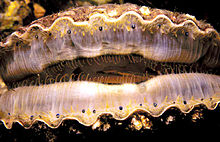Yes, scallops are mysterious things.

Dead, a scallop is tender and sweet. Alive, it's slightly sinister. Those dots round the edge of the scallop shell are all eyes. There may be as many as a hundred of them.
Watching you.
Scallops can come up on you surprisingly fast. Some swim (the Singing Scallops make a popping noise as they flap their shells) and some burrow.
Some are male, some are female, some are both - and some start off one and then swop to being the other.
Scallops are a sign of pilgrimage, especially of pilgrimage to Compostela to the shrine of St James. In mediaeval times someone who had been on a pilgrimage might wear a scallop shell on their hat in the same way that people nowadays use a holiday photograph on their Facebook profile. The scallop shell also acted as a begging bowl - pilgrims were allowed just as much food as they could scoop up in their scallop.
The scallop is also a symbol of new life, and this is why Aphrodite, goddess of love, has a connection with the scallop.

This statue was made in Southern Italy in the 2nd century BC.
So they're wonderful things, scallops. Tasty, too (though in Australia a scallop may be a sort of fried potato cake).
If you scallop something you may be decorating it with scallop shapes, and this may be the easiest way to spot one: on the edge of a sleeve or a lampshade or a pillar. Something baked with a covering of breadcrumbs is scalloped, too.
But do watch out for those hundred eyes...
Spot the Frippet: scallop. This word comes from the French word escalope, which means shell.
No comments:
Post a Comment
All comments are very welcome, but please make them suitable for The Word Den's family audience.